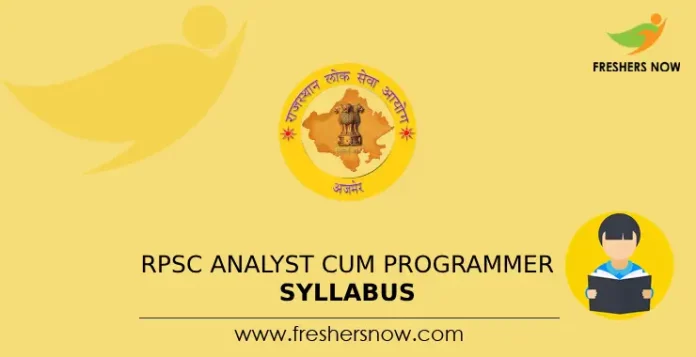
RPSC Analyst – Programmer Syllabus 2025 PDF Download & Exam Pattern: The Rajasthan Public Service Commission (RPSC) has announced the notification for the Analyst – Programmer (Deputy Director) post. The selection process includes a written test and, an interview. For the Examination process, the RPSC Analyst – Programmer Syllabus 2025 is very crucial for the candidates.
RPSC Analyst – Programmer Syllabus 2025
The RPSC Analyst – Programmer Exam Pattern 2025 includes various subjects and is designed to test the abilities of the candidates. Candidates need to understand the exam pattern thoroughly, each carrying a weightage of 150 marks with a duration of 2 Hours & 30 minutes. Here, In this article, We have provided a direct link to download the RPSC Analyst – Programmer Exam Syllabus 2025 and Exam Pattern.
RPSC Analyst – Programmer Syllabus 2025 – Overview
| RPSC Analyst – Programmer Syllabus 2025 | |
| Organization Name | Rajasthan Public Service Commission (RPSC) |
| Post Name | Analyst – Programmer (Deputy Director) |
| Category | Syllabus |
| Selection Process | Written test, Interview |
| Location | Rajasthan |
| Official Site | rpsc.rajasthan.gov.in |
RPSC Analyst – Programmer Exam Pattern 2025
It is strongly recommended that all candidates obtain precise details concerning the RPSC Analyst – Programmer Syllabus 2025 Download Link, as this pattern holds significant importance for applicants in preparing for the upcoming examination.
| S. No | Subject | No Of Questions | Total Marks | Examination Duration |
|---|---|---|---|---|
| 1. | Paper-I | 100 | 100 | 2 Hours |
| 2. | Paper-II | 100 | 100 | 2 Hours |
| Total | 200 Marks | 200 Marks | — | |
RPSC Analyst – Programmer Exam Syllabus 2025
PAPER – I
Reasoning Test, Numerical Analysis & General Knowledge
- Problem Solving
- Data Interpretation
- Data Sufficiency
- Logical Reasoning and Analytical Reasoning
- General Knowledge and Current Affairs (India and Rajasthan)
Database Management Systems (DBMS)
Data Models & Design
- ER Diagram
- Relational and Object-Oriented Databases
- Conceptual Database Design
- Normalization
- Primitive and Composite Data Types
- Concept of Physical and Logical Databases
- Data Abstraction and Data Independence
- Data Aggregation
- Relational Algebra
Application Development using SQL
- Host Language Interface
- Embedded SQL Programming
- Stored Procedures, Triggers, and Views
- Constraints and Assertions
Internal of RDBMS
- Physical Data Organisation: Sequential, Indexed, Random, and Hashed Files
- Inverted and Multilist Structures
- B-Trees, B+ Trees
- Query Optimisation
- Join Algorithms
Transaction Processing
- Concurrency Control and Recovery Management
- Transaction Model: Properties and States
- Serializability
- Lock-Based Protocols, Two-Phase Locking
Distributed Systems
- Multi-user and Multiprocess Operating Systems
- Requirements for Client Interfaces in Distributed Application Environments
Data Communication and Computer Networks
- Computer Network Architecture
- Switching Techniques: Circuit, Packet, and Message Switching
- Network Structure
- OSI Layers: Physical Layer, Data Link Layer (Framing, Retransmission Algorithms)
- Multiple Access Protocols: ALOHA, CSMA/CD, Ethernet
- High-Speed LANs and Network Topologies
- Broadcast Routing and Spanning Trees
- TCP/IP Stack
- IP Networks and Internet
- DNS and Firewalls
- Intrusion Detection and Prevention
- Transport Layer and TCP/IP Functions
- Network Management and Interoperability
PAPER – II
System Analysis and Design
System Concept
- Definition and Characteristics
- Elements and Boundaries
- Types of Systems
System Development Life Cycle (SDLC)
- Recognition of Needs
- Feasibility Study
- Prototyping
- Role of System Analyst
System Planning and Tools
- Data Flow Diagrams (DFD)
- Data Dictionary
- Decision Trees
- Structured Analysis and Decision Tables
- IPO Charts
- Structured Walkthrough
Form Design
- Input and Output Form Design
- Requirement and Classification of Forms
- Layout Considerations
- Form Control
Object-Oriented Design
- Concepts and Methods
Software Engineering & Development
Software Life Cycle & Paradigms
System Analysis
- Feasibility Study
- Requirement Analysis
- Cost-Benefit Analysis
- Planning Systems
- Analysis Tools and Techniques
System Design
- Design Fundamentals
- Modular Design
- Data and Procedural Design
- Object-Oriented Design
System Development
- Code Documentation
- Program Design Paradigms
- Efficiency Considerations
Verification, Validation & Testing
- Testing Methods
- Formal Program Verification
- Testing Strategies
Software Maintenance
- Characteristics of Maintenance
- Maintainability
- Maintenance Tasks and Side Effects
Software Project Management
Concepts
- The Management Spectrum: People, Product, Process, and Project
Software Process & Project Metrics
- Software Measurement
- Size-Oriented Metrics
- Function-Oriented Metrics
Software Project Planning
- Objectives
- Decomposition Techniques
- Empirical Estimation Models
Risk Analysis and Management
- Risk Identification
- Risk Projection
- Risk Refinement
- Risk Monitoring and Management
Project Scheduling and Tracking
Software Quality Assurance (SQA)
Software Configuration Management (SCM)
RPSC Analyst – Programmer Syllabus 2025 Download Link
| RPSC Analyst – Programmer Syllabus 2025 PDF Download | |
| To Download The RPSC Analyst – Programmer Syllabus 2025 | Download Syllabus |
Regularly, keep visiting our website Freshersnow.com for more latest and updated information. We expect all aspirants to have the RPSC Analyst – Programmer Syllabus 2025 PDF Download from the attached direct link.



